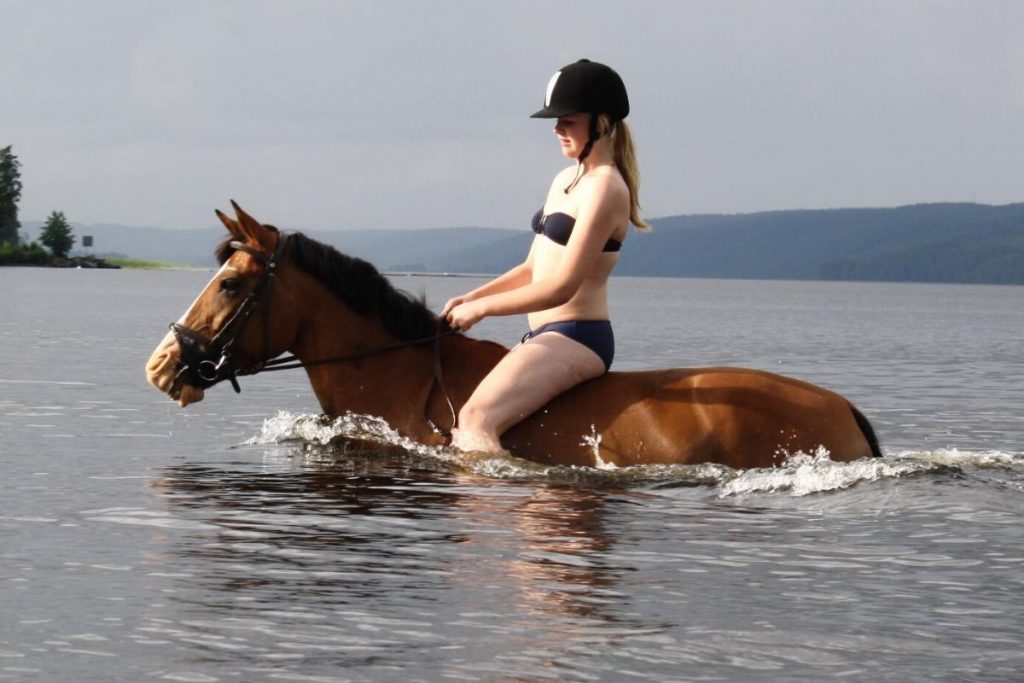One of the most common questions that comes up when horses and water are mentioned in the same sentence, is can they swim, and should you take them swimming while riding them?
The reason that this question comes up a lot is because generally, horses need a lot of encouragement to get into the water because they can be afraid of it.
The short answer to this question is that, yes horses can swim, and it can be an extremely beneficial aerobic exercise for them. Let’s explore this a little further though, and go over whether horses like swimming, whether you can ride them in water, what equine hydrotherapy is, and why some horses are more afraid of water than others.
Do Horses Know How to Swim & Do They Like Swimming?
Yes, horses know how to swim naturally and do not need to be taught by an owner or rider. On an extremely hot day out, the exhilaration of a cold-water swim is something that horses do enjoy very much.
It doesn’t matter whether the swim is in the ocean, in a pool, or in your local river, they will love it permitting that they have good experiences with water in general. Horses are extremely strong swimmers (for the most part) and if they get into the water on a regular basis, it can have tremendous health benefits.
How Does a Horse Swim, Exactly?
The motion that a horse makes in order to swim is similar to how large dogs look in the water. The horse will keep it’s head above the water and kick it’s way through the water in order to move themselves forward. When you take a look at how this looks from underneath the surface of the water, it almost looks like they are running.
Why Are Some Horses Afraid of Water?
If a horse’s first experience with water is a negative one, this is going to shape their feelings about water and what their reaction will be when they get into the water. If you try to push your horse into the water when they are not ready or are unsure of how to swim, they can become fearful of it.
The key idea here is to understand that a horse’s eyes are on either side of their head, meaning that they do not have any kind of depth perception. This can make them anxious as they can’t see what you see.
A puddle to you, may look like they are about to fall off a cliff to them. If your horse is afraid of water, it is important to not get them to cross a large body of water until you’ve done some training with them and do not force them into the water nor show anger or disappointment towards them as this can make the fear worse.

Tips for Riders/Owners With Horses Afraid of the Water
- Horses learn from following the leader, so you need to show them some examples of how water is not something to be fearful of. Try bathing your horse in a small puddle to get them used to being around the water. If you have more than one horse, keep them together during the learning process as the fearful horses can take encouragement from the ones that are brave. Remember that the trust that your horse has in you, will help them thrive and become confident.
- Try lunging your horse into the water for a short distance and then circle back out before they become too nervous or anxious. Slow exposure can go a long way to making it easier for your horse.
- Once your horse can walk through the small puddle without fear, take them to a small river next. Always start off slowly and never force your horse into the water. Always lead by example and understand that it can take days, weeks, or even months to get them into the water.
- When you are finally able to swim with your horse (beside them), never stay near their legs. They may kick you accidentally.
- If you have dogs that your horse is accustomed too, keep them with you when crossing larger bodies of water during the training period. The horses will feel more comfortable and the dogs will help keep you aware of any potential dangers.
- Always be on the lookout for items in bodies of water that can cause harm. Things like broken bottles and metal, as not only can these be dangerous for you and your horse, it can undue all of your training if your horse has a negative experience.
- When swimming with your horse (on their back), always stay forward of the withers so that he or she does not strike you with their forward movement.
Always use a bridle and a lead rope during training so that you can move your horse’s shoulders on cue. This is critical for when you get into the water as your horse will have no other cues to rely on.

Can You Ride Your Horse in Water?
While the answer to this question is undoubtedly, yes; you do have to be careful with how you go about it as getting knocked off or thrown from your horse while riding them in water can be very dangerous for you.
You will need to make sure that your hose can respond to rein cues on dry land before you get into the water with them, as you will not be able to see their body and they will not be able to see yours, and so body language will be of no help.
If your horse is scared at all, it is likely that they will topple you off and this puts you in immediate danger of either getting kicked or having a thousand-pound horse on top of you as they struggle to get out of the water.
Can You Cross Large Bodies of Water
Like an Ocean or Lake?
One of the most common images you see in old
western movies is horses crossing vast bodies of water like big rivers, lakes,
and sometimes the sea. While horses can indeed cross large bodies of water like
rivers, how far they can actually go is mainly dependent on their energy levels
and their power. If you’ve traveled hundreds of miles and want to tackle a
large body of water, it is not recommended as your horse will need rest.
What Is Equine Hydrotherapy?
Equine hydrotherapy is used
as a form of rehabilitation to help relieve horses from pain, recover from
injury, and built up their fitness levels namely in the areas of performance
and endurance. There are generally four types of equine hydrotherapy, each used
to pinpoint a specific set of issues and are outlined below.
- Having a horse just swim in water can help with injuries related to ligament damage.
- Having a horse use a water treadmill can help improve their range of movement.
- Having a horse in low temperature water can help with inflammation.
- Having a horse in a cold hosing environment can help reduce fluid buildup and provide pain relief.
Equine hydrotherapy works by first introducing a horse to a dry treadmill, then a water treadmill second. The water treadmill helps the horse sit back, take its weight off of its forelimbs, and take longer strides than they would on dry land.
While this is a low-intensity workout for the horse, it is fantastic for reducing inflammation in the muscles and fluid buildup in the joints. Once the horse is used to the treadmill, they may be moved to an oval shaped pool, which is a bit harder for the horse to get used to but will help develop their fitness.
Common ailments that hydrotherapy can help treat include sacroiliac joint pain, back problems, kissing spine, degenerative joint disease, ligament injuries, and injuries to tendons.
